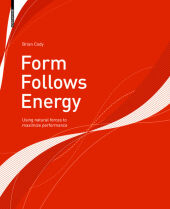 Neuerscheinungen 2017Stand: 2020-02-01 |
Schnellsuche
ISBN/Stichwort/Autor
|
Herderstraße 10
10625 Berlin
Tel.: 030 315 714 16
Fax 030 315 714 14
info@buchspektrum.de |

Brian Cody
Form Follows Energy
Using natural forces to maximize performance
2017. 280 S. 306 col. ld. 300 mm
Verlag/Jahr: BIRKHÄUSER BERLIN 2017
ISBN: 3-03-561405-9 (3035614059)
Neue ISBN: 978-3-03-561405-3 (9783035614053)
Preis und Lieferzeit: Bitte klicken
Architektur ist Energie. Architektonische Entwürfe entscheiden oft für Jahrzehnte und manchmal Jahrhunderte über den damit verbundenen Energie- und Materialverbrauch.
Form Follows Energy analysiert das Verhältnis zwischen Energieströmen und der Form unserer gebauten Umwelt. Es untersucht die Optimierung der Energieflüsse in Architektur und Städtebau und ermittelt daraus neue Ansätze. Die komplexen Zusammenhänge zwischen Architektur und Energie werden in Fallstudien veranschaulicht. Handgezeichnete Diagramme zeigen auf, wie Energieplanungsstrategien genutzt werden können, um maximale Energieeffizienz zu erzielen.
Der Autor greift in seiner Darstellung auf fast 30 Jahre Praxis, Lehre und Forschung zurück und stellt ein komplexes Thema für Architekten und Bauingenieure leicht verständlich dar.
Architecture is energy. Lines drawn on paper to represent architectural intentions also imply decades and sometimes centuries of associated energy and material flows. Form Follows Energy is about the relationship between energy and the form of our built environment. It examines the optimisation of energy flows in building and urban design and the implications for form and configuration. It speaks to both architectural and engineering audiences and offers for the first time a truly interdisciplinary overview on the subject, explaining the complex relationships between energy and architecture in an easy to follow manner and using simple diagrams to show how energy design strategies can be used to maximize the energy performance of our built environment, while at the same time leading to new aesthetic qualities and radically new forms in architecture and urban design. Case studies are used to illustrate the theory. The books philosophy is based on the guiding principles underlying nearly 30 years work in practice, research and teaching. It is relatively easy to make something simple seem complicated. To make a complex topic seem simple and easily understandable is far more of a challenge and this is the aim of this book.
Prof. Brian Cody Leiter des Instituts für Gebäude und Energie, TU Graz
Prof. Brian Cody Head of Institute of Buildings and Energy, Technical University of Graz, Austria


